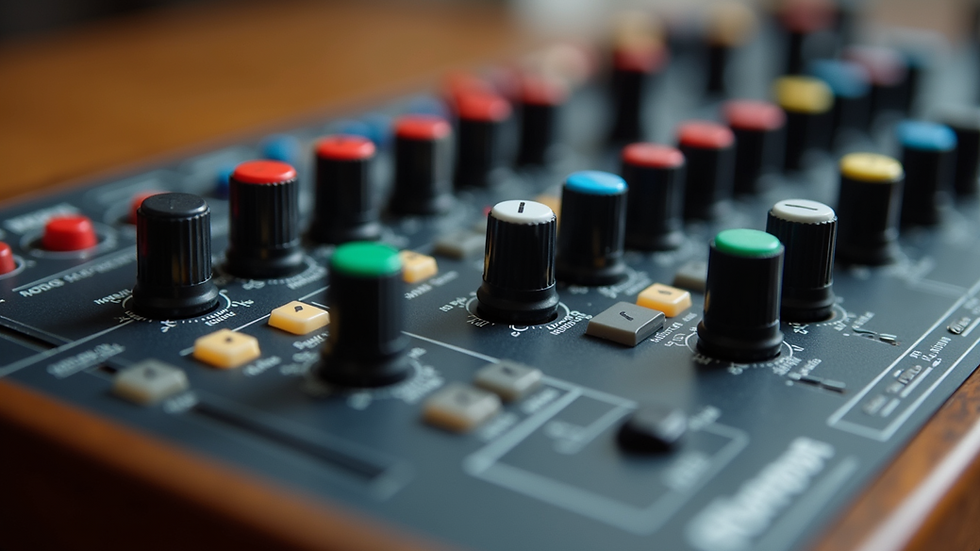Unlocking Creativity: How Unique Music and Sound Design Elevate Your Projects to New Heights
- Mr. Watt

- Aug 19
- 4 min read
In today's crowded landscape of films and games, standing out is more important than ever. With millions of titles vying for attention, creators need innovative strategies to capture their audience's interest. One of the most effective ways to achieve this is through unique music and sound design. By stepping away from conventional soundscapes, filmmakers and game developers can craft immersive experiences that resonate deeply with viewers and players alike.
This blog post explores the transformative impact of creative sound choices, backed by successful examples that have embraced this innovative approach.
The Power of Sound in Storytelling
Sound is not just an accessory to storytelling; it is a key component that defines the narrative. It sets the mood, enhances emotional depth, and can even hint at future events. Traditional soundtracks often rely on predictable melodies, which can diminish the viewer's anticipation. However, choosing unconventional music and sound design opens new avenues for creativity.
Take, for example, the film Inception. Hans Zimmer's score employs a clever manipulation of time and sound, generating urgency and tension that reflect the film's core themes. In contrast, A Quiet Place utilizes silence to intensify suspense and encourage audience engagement, pulling viewers into a more profound connection with the film.
Both of these examples illustrate how innovative sound choices elevate storytelling, creating a more immersive and enduring experience for the audience.
Breaking the Mold: Unique Sound Design Techniques
To set their projects apart, filmmakers and game developers can explore a variety of distinctive sound design techniques. Here are some approaches that can significantly enhance your work:
1. Field Recordings
Field recordings capture sounds from the real world, adding authenticity and texture to projects. For instance, in The Revenant, the sound design incorporates natural sounds from the wilderness that immerse the audience in the harsh conditions faced by characters. This approach can elevate realism and emotional impact by grounding the narrative in reality.
2. Unconventional Instruments
Incorporating unusual instruments can create unique soundscapes. The film Her features a score by Arcade Fire that includes a mix of atypical instruments, resulting in a sound that feels both futuristic and relatable. This distinct musical choice enhances the film's exploration of technology and human connection, making it resonate deeply with viewers.
3. Layering Sounds
Layering different sounds creates a rich auditory experience that can transport users to other worlds. In the game Journey, sound design masterfully combines music, environmental noises, and player-generated audio. This dynamic layering enhances gameplay while fostering emotional connections between players and the game world.
4. Silence as a Tool
Silence can wield incredible power. In A Quiet Place, the deliberate absence of sound amplifies tension, forcing the audience to focus intently on visual storytelling. This technique is particularly effective in horror and thriller genres where the anticipation of sound can elevate fear.
Successful Examples of Unique Music and Sound Design
Numerous projects have effectively harnessed unconventional music and sound design to create unforgettable experiences. Here are a few standout examples:
1. Stranger Things
The Netflix series Stranger Things is famous for its nostalgic 80s synth-heavy soundtrack. The Duffer Brothers worked with Kyle Dixon and Michael Stein to create a score that pays homage to classic horror and sci-fi films. The blend of electronic sounds and retro vibes not only sets an engaging tone but also evokes a strong sense of nostalgia, helping it stand out in the competitive streaming market.
2. Mad Max: Fury Road
Mad Max: Fury Road showcases exemplary sound design. The film's sound team, led by Mark Mangini and David White, crafted a chaotic yet cohesive audio experience that perfectly complements the film's frantic visuals. From the roaring engines to the haunting score by Junkie XL, every sound element is meticulously designed to enhance immersion in the post-apocalyptic world.
3. Inside
The indie game Inside offers a minimalistic sound design that aligns with its dark narrative. Ambient sounds and subtle musical cues cultivate an unsettling atmosphere, drawing players into the game's eerie landscape. This technique demonstrates how effective sound can elevate gameplay and storytelling, even in visually simple environments.

Embracing the Future of Music and Sound Design in Film and Gaming
As technology continues to advance, so do the possibilities for music and sound design. Innovations in virtual reality (VR) and augmented reality (AR) are redefining how sound can be perceived. In these immersive environments, sound design is essential in creating a genuine sense of presence.
Filmmakers and game developers should actively explore these advancements and experiment with fresh techniques to keep their projects engaging. Custom music and sound design tailored to the unique vision of a project can allow creators to forge connections that resonate with their audiences on a deeper level.
Your Next Steps in Sound Design
In an era overflowing with content, utilizing unconventional music and sound design can be your secret weapon for achieving standout projects. By moving away from standard soundscapes and embracing innovative techniques, filmmakers and game developers can create experiences that truly captivate audiences.
Successful examples like Stranger Things, Mad Max: Fury Road, and Inside reveal the power of unique sound design in enriching storytelling. As technology evolves, the potential for creativity in music and sound design continues to expand. Embrace your creativity and explore the endless possibilities that await in the realm of sound. Your project deserves to be heard in a way that lingers long after the experience concludes.



Comments